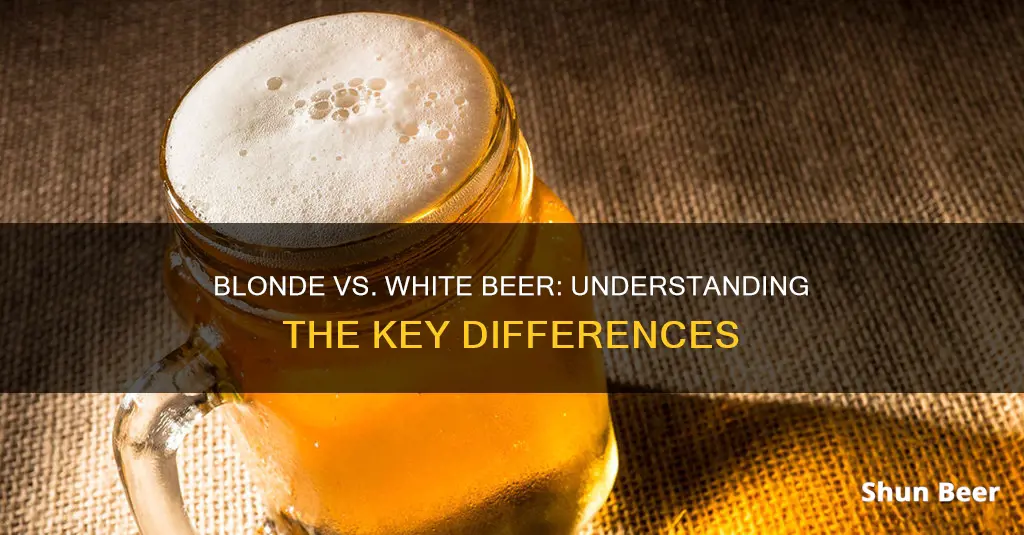
White beer and blonde beer are two distinct styles of beer with different brewing processes, flavours, and serving methods. White beer, also known as Witbier, is a Belgian-style wheat beer that is unfiltered and top-fermented, resulting in a cloudy appearance. It is brewed with a combination of malted wheat and barley, and spiced with coriander and orange peel, giving it a subtle citrus and floral flavour. Blonde beer, on the other hand, is a more general term for a light-coloured ale or lager. It is typically brewed with malted grains and hops, resulting in a slightly sweet and mild bitter flavour. Blonde beers are usually clearer and have a lower alcohol content than white beers, making them a popular choice for a refreshing drink.
What You'll Learn

Blonde beer is a lager or an ale
Blonde beer is an ale. Ales are created through top fermentation, a process in which yeast ferments at warmer temperatures and settles at the top of the beer. Blonde ales are approachable and easy to drink, with no particularly dominating malt or hop characteristics. They are rounded and smooth, with a light malt sweetness and fruity ester flavours. Blonde ales can be fermented with lager or ale yeast and can have honey, spices, and fruit added.
Blonde ales are distinct from white ales, which are also known as Witbiers. Witbiers are Belgian-style beers made with unmalted wheat, orange peel, and coriander. They are tart, light in body, and moderately alcoholic.
Lagers and ales are the two broad categories of beer, differentiated by the type of yeast and fermentation process used. Lagers are made with bottom-fermenting yeast and fermented at cooler temperatures, while ales are made with top-fermenting yeast and fermented at warmer temperatures. Lagers tend to be lighter and less challenging in flavour, making them a typical entry point for new beer drinkers.
Explore Beer Diversity: Styles, Tastes, and Brewing Secrets
You may want to see also

White beer is a Belgian-style wheat beer
White beer, also known as Witbier, is a Belgian-style wheat beer. It is typically unfiltered, top-fermented, and brewed with a combination of malted wheat and barley, giving it a light and refreshing taste. The use of wheat also gives white beer its distinctive cloudy appearance.
White beers often include a range of spices and flavourings, such as coriander, which adds a citrusy note, and orange peel, which imparts a sweet, fruity flavour. Other spices that may be used include chamomile, ginger, and cardamom. The hops used in white beer are usually mild, with low bitterness, so as not to overpower the other flavours.
White beer is typically served in a tulip glass at a temperature of 5 to 7 degrees Celsius, which helps to accentuate its subtle spices and citrus notes. Its unique flavour profile and appearance make it a popular choice among beer lovers worldwide.
As a Belgian-style wheat beer, white beer has a long history that can be traced back to the Middle Ages. However, by the 1950s, interest in the style had waned, and it was considered extinct. It was then revived by a man named Pierre Celis, who brewed it at his brewery in Hoegaarden, Belgium. This beer, now known as Hoegaarden, became wildly successful and led to a resurgence in the style's popularity.
Today, white beer is enjoyed for its light, refreshing taste and distinctive appearance. It pairs well with a wide range of foods, making it a versatile choice for beer lovers. Its unique flavour profile, characterised by notes of citrus, spice, and wheat, sets it apart from other types of beer.
Salt Life Beverage LLC: Exploring Their Beer Variety
You may want to see also

Blonde beer is lighter in flavour
Blonde beers are also known for their fruity notes, which can include apple, pear, citrus, or banana-like flavours. They are often sweeter than other pale ales and have less bitterness. In terms of appearance, blonde ales range from light yellow to deep gold in colour and have a low to medium white head.
American blonde ales are lightly malted with all barley, very little hops, and an American yeast strain. Belgian blonde ales, on the other hand, are fermented with a Belgian yeast that produces more distinct flavours and aromas.
White beers, or Witbiers, have a long history that can be traced back to the Middle Ages. However, their popularity waned in the early 20th century due to the rising popularity of pilsner and pale lagers. By the 1950s, no one was brewing Witbiers commercially, and the style was considered extinct. It was only thanks to the efforts of a man named Pierre Celis, who revived the style at his brewery in Hoegaarden, Belgium, that Witbiers regained their popularity.
Real Ale vs Beer: What's the Difference?
You may want to see also

White beer is unfiltered and top-fermented
White beer, also known as Witbier, is a Belgian-style wheat beer that is unfiltered and top-fermented. This traditional brewing method gives white beer its distinctive character and flavour profile.
Unfiltered beers are left in their natural state, without removing the yeast and wheat proteins that give white beer its cloudy appearance. This also contributes to a fuller body and mouthfeel, and a more complex flavour. The top-fermentation process further enhances the flavour and aroma of the beer. Top-fermenting yeasts work at warmer temperatures, typically between 60°F and 70°F (15°C and 21°C), which encourages the development of fruity, spicy notes. This is why white beers often have hints of banana, clove, and vanilla.
The combination of unfiltered wheat beer and top fermentation results in a unique, cloudy appearance and a rich, spicy, and fruity flavour. White beers are often brewed with malted wheat and barley, and spiced with coriander and orange peel, adding to their refreshing, light, and citrusy character.
The top fermentation of white beers also encourages a more active fermentation process, with yeast working at the top of the brew. This method is traditionally associated with ales, which are typically fermented at warmer temperatures than lagers. The warmer temperatures allow for a wider range of flavour compounds to be produced, resulting in the distinctive notes found in white beers.
White beers, with their unique brewing process, offer a complex and flavourful drinking experience. The combination of unfiltered wheat and top fermentation creates a beer style that is loved by many for its refreshing taste and citrusy, spiced notes.
Beer vs Whisky: A Guide to Their Differences
You may want to see also

Blonde beer is served colder than white beer
Blonde beer, a light-coloured ale or lager, has a clean, crisp flavour profile. It is typically brewed with a combination of malted grains and hops, resulting in a slightly sweet taste with mild bitterness. The emphasis on malt flavour and controlled brewing temperature gives blonde beer its signature light and refreshing taste. Serving it colder further accentuates its crisp and refreshing nature.
On the other hand, white beer, also known as witbier, is a Belgian-style wheat beer. It is unfiltered and top-fermented, resulting in a cloudy appearance due to the suspended yeast and wheat proteins. White beer often includes spices such as coriander and orange peel, adding subtle citrus and floral notes. Serving white beer at a slightly warmer temperature helps highlight these delicate flavours.
The difference in serving temperature between blonde and white beer is not just a matter of preference but also a way to optimise the drinking experience for each style. The colder temperature for blonde beer enhances its crispness, while the slightly warmer temperature for white beer brings out its subtle spices and citrus flavours.
Additionally, the glassware choice can also impact the drinking experience. Blonde beer can be served in a variety of glasses according to personal preference, while white beer is traditionally served in a tulip glass, which complements its flavour profile.
In summary, blonde beer and white beer are distinct styles with unique characteristics. The serving temperature plays a crucial role in accentuating their flavours, with blonde beer served colder to enhance its crispness and refreshment, and white beer served slightly warmer to highlight its subtle spices and citrus notes.
Exploring Beer, Whisky, and Rum: Unique Distinctions
You may want to see also
Frequently asked questions
White beer, or Witbier, is a Belgian-style wheat beer that is unfiltered and top-fermented. Blonde beer, on the other hand, is a lager or an ale, and is typically filtered.
White beer is brewed with wheat and often spiced with coriander and orange peel. Blonde beer is brewed with malted grains and hops, and sometimes with wheat.
White beer is light in colour, ranging from pale to light blond, and has a cloudy appearance due to the suspended yeast and wheat proteins. Blonde beers can vary in colour from pale straw to golden or light amber.
White beer has a citrusy, spiced flavour profile. Blonde beer is malt-forward with notes of bread or caramel, and a mild bitterness.
White beer is traditionally served in a tulip glass at a temperature of 5 to 7 degrees Celsius. Blonde beer is served colder, at around 3 to 5 degrees Celsius, and can be enjoyed in a variety of glassware.







